Write 300400 words review of the paper using your own words
Write 300-400 words review of the paper \"using your own words and not copying anything form the article\".
Karin Slegers
CUO | Social Spaces
KU Leuven - iMinds
Parkstraat 45, bus 3605
3000 Leuven, Belgium karin.slegers@soc.kuleuven.be
Pieter Duysburgh
SMIT, VUB - iMinds Pleinlaan 9
1050 Brussels, Belgium pieter.duysburgh@vub.ac.be
Abstract
Niels Hendriks
Social Spaces | CUO
LUCA - KU Leuven
C-Mine 5
3600 Genk, Belgium niels.hendriks@luca-arts.be
Author Keywords
Participatory design; Ethics; Cognitive impairments; Sensory impairments;
ACM Classification Keywords
H.5.m. Information interfaces and presentation (e.g., HCI): Miscellaneous.
Introduction
It has been acknowledged that doing participatory design with people living with cognitive or sensory impairments can be quite difficult. As the experiences of persons living with impairments, such as autism spectrum disorder, Alzheimer’s disease or hearing impairments, might be fundamentally different from their own, it is more difficult for researchers and designers to identify with or relate to their users [8,11].
An additional complicating issue is the fact that many participatory design methods fail in their inclusiveness with regard to people living with impairments [13]. In participatory design, researchers should provide their participants with appropriate tools for expressing themselves [14]. However, common participatory design tools may not be appropriate when working with people living with impairments. Such tools frequently draw upon exactly those skills that people living with cognitive or sensory impairments have problems with.
Ethical Issues in Participatory Design with People living with Cognitive or Sensory Impairments
Participatory design with people living with cognitive or sensory impairments poses several challenges on researchers and designers, due to differences in their mutual experiences and due to the fact that many methods and techniques may not be appropriate and need adjustment. Many of those challenges are related to ethical issues. This paper describes several of such challenges that emerged during a series of three academic workshops focusing on adjusting participatory design approaches when working with people living with cognitive or sensory impairments. We plead for a new tradition of sharing experiences in order for researchers and designers to learn from one another in the form of codesign stories.
Many methods are, for instance, based on verbal or visual expressions, and use visual and/or hands-on techniques. Also, higher order cognitive skills are often required [2,14], such as abstraction, conceptualization or creative thinking. As a result, common participatory design techniques, and research approaches in general, may not be usable, or at least need adjustment.
This idea that the involvement of people living with impairments in the design process requires a different, more appropriate approach, matches recent views on disability. Traditionally, the medical model of disability views an impairment as a functional limitation that is situated within an individual and that should be treated to overcome. The social model of disability, however, assumes that a disability is the result of society\'s response to a person\'s functional limitations [1]. According to this model, it is important to remove any barriers that might prevent a person with a functional limitation to participate fully in society. In terms of participatory design, this implies that researchers should make their projects accessible and use appropriate techniques that take away any barriers that might prevent participation of people with impairments. The cultural model of disability goes even further. Rather than treating a disability, or creating a society that does not limit participation, this model defines persons living with an impairment as a unique cultural group, sharing similar experiences, tacit rules, language and discourse [4]. This model would plead for tailoring participatory design tools to the specific (cultural) needs, norms, values, and expressions of a particular group of participants with impairments.
Workshop series
In order to further understand how researchers and designers should adjust their participatory design approach, we organized a series of academic workshops at the Participatory Design Conference 2012 [18], at INTERACT 2013 [15] and at CHI2014 [16]. These workshops brought together 42 researchers and designers who were involved in participatory design with people living with cognitive or sensory impairments. The workshops facilitated researchers and designers to share experiences (best practices, failures, lessons learnt, ...) regarding the adjustments they made in their participatory design approaches in order to derive general principles or guidelines.
During the workshops, we mapped the challenges that researchers and designers commonly struggle with when involving people living with impairments in participatory design. The challenges that emerged can roughly be divided into six categories: 1) positioning the impairment in a participatory design project; 2) equivalence in participation; 3) balancing viewpoints of the stakeholders; 4) ethical challenges & impact of participation; 5) adapting existing participatory design techniques; and 6) data collection & analysis.
Although the challenges that emerged seemed very general of nature and were not related specifically to working with persons with cognitive or sensory impairments, they do seem to become more apparent when involving such users. This may be explained by the idea that understanding others becomes more complex when the “differences between the cultural assumptions of designers and users are potentially greater” [11, p.21]. That is, although the challenges we identified are relevant for any design project, they
become more prevalent when the world of designers and researchers differs (too much) from the world of persons living with impairments. Similar challenges will also become more relevant when working with other vulnerable users or in sensitive settings.
Ethical encounters in participatory design
Several challenges that emerged from our own workshops are especially relevant for ethical issues. We discuss the most relevant challenges below.
Practical ethical challenges
Some of the ethical challenges that were reported are highly practical in nature. Informed consent, for instance, is a difficult matter when working with people with cognitive impairments. Researchers and designers worry about how to properly explain the official and legal aspects of a design project to participants and their proxies. When working with people with dementia ourselves [6,19], for instance, the official ethical procedure we had to follow required the participants’ next-of-kin to sign the informed consent form. Doing only this did not feel right, as we wished to involve the people with dementia as full participants. In practice, however, it was difficult to inform participants with dementia about our goals and approach.
Also related to procedural ethics is the fact that researchers and designers had experienced that they should be very flexible, both when preparing participatory design projects and when using design techniques with their participants. Often, changes regarding the approach or specific techniques need to be made on the spot, based on the individual participants and context, which is impossible to fully account for in official ethical applications.
Impact of participation
Besides the practical ethical issues mentioned above, deciding how to deal with the possible impact of participation in a project can even be more of a challenge. For instance, it can be quite difficult for participants to be confronted with their own limitations, or with other participants living with similar impairments (especially when the impairment has a degenerative nature and other participants are limited more severely). In addition, many researchers expressed concerns about possible ethical challenges for their participants of which they are not even aware. A related challenge that came up frequently during the workshops, and which has rarely been recognized before, is the impact of working with people living with impairments on researchers and designers themselves. Many researchers indicated that some of their projects had been emotionally impactful for them, and that they had felt insufficiently prepared for dealing with the participants at the start of their projects. In our own projects with people with dementia, we were confronted with participants who passed away during the projects quite a few times. In addition, when visiting people with dementia several times during a longer period, the degenerative character of their disease becomes quite apparent, as does the emotional impact this has on both the patient and their family. It was suggested several times in our workshops to not only focus on the possible impact of a project on the participants in ethical approval, but to include the impact on researchers as well.
Achieving equivalence
Besides the challenges concerning concrete ethical issues described above, the challenge of achieving equivalence in participation emerged during our
workshops, which is strongly related to maintaining boundaries. Equivalence is an important aspect in participatory design and most researchers aim for equal contributions from all stakeholders involved in the design process (end-users, caregivers, parents, researchers, designers, developers, etc.). In this regard, our workshop participants agreed on the importance of, for instance, supporting collaboration between participants, finding a shared language and creating common goals, and aiming for meaningful, valuable experiences for all participants in a safe environment. Although several approaches and activities were presented and discussed to realize equivalence, it became clear that many researchers worry about achieving true equivalence.
Balancing stakeholders’ viewpoints
An issue that further complicates equivalence in design is finding a balance between the (sometimes conflicting) viewpoints of the stakeholders in the different design decisions taken. When working with people living with impairments, each stakeholder participates from the viewpoint of their particular role (e.g. a caring role, a teaching role, a partner role, a parenting role). Several researchers in our workshops reported situations of conflicting interests and indicated to find it difficult to interpret and marry the stories
from the different stakeholders without picking the side of one stakeholder. In our own research with children with hearing impairments [3,17] for instance, we found that medical experts may have different opinions on the importance of teaching sign language and spoken language than either school teachers and psychologists or parents (whose views may further differ due to their own hearing situation).
Limited knowledge of participants’ impairments
This balancing act is further complicated by the fact that researchers and designers often have limited knowledge of the impairment their participants are dealing with. Researchers feel they have to rely on the (sometimes conflicting) experiences of the users and their proxies in the participatory design process. To overcome this challenge, some researchers and designers suggest to provide for an openly unbalanced participation of persons living with an impairment: they are overtly assigned the role as expert or get hired as a paid team member of the project [5].
Positioning impairments
The final challenge we would like to discuss in light of this workshop is the challenge of positioning the participants\' impairments in a participatory design project. Researchers seem to struggle with their view on the impairment within the framework of their project. In our work with children with hearing impairments for instance, we soon learned that the community of people living with hearing impairments do not consider themselves as being impaired. Instead, they see themselves as a cultural group, referring to ‘Deaf culture’. In their view, a hearing impairment is a different human experience rather than a disability [9], which is completely in line with the cultural view on disability discussed above.
Many of the researchers and designers in our workshops indicated that they prefer a positive view on the impairment of their participants and try to choose and adapt participatory design techniques based on their participants\' abilities (i.e. their strengths and skills) rather than their disabilities. This is not always a straightforward process, especially since researchers
often aim to provide a wide variety of tools to facilitate participants to express themselves, accounting for the diversity within groups of people living with a specific impairment. This may leave researchers with the feeling of compensating for disability rather than starting from the abilities of their participants.
A final challenge that was brought up in this respect, is that researchers experience insecurity about how to address the impairment in their interactions with participants. They are very aware that sensitivities may exist in this regard and explicitly try to find an appropriate vocabulary. It was suggested in one of our workshops to adopt a preparatory participatory design approach, involving the participants with impairments in setting up the actual design project.
Sharing ethical stories
Based on our workshop findings, we came to the view that doing participatory design with people living with cognitive or sensory impairments requires researchers and designers to adjust their design approach and the techniques they use to the individual characteristics of each participant and each design context. In order for researchers and designers to learn from the work of others, we suggest to adopt a lively tradition of sharing so-called ‘codesign stories’ in the field of participatory design with people living with impairments [7]. This suggestion is based on Lee’s method stories [11], with which she pleads for a renewed attention for the making process of methods: a focus on “what designers actually do and feel when making their methods work” (p.1) and not on the data, the interviews or observation notes as end result of the followed method. Method stories, in this sense, are background stories which share the context, the application and adjustment of a
method used in a specific context and which try to make explicit the designers’ or researchers’ backgrounds and assumptions.
Regarding ethical encounters, our suggestion includes several issues that researchers and designers should discuss in their codesign stories. We would like to encourage researchers to, for instance, carefully reflect on their considerations and experiences regarding ethical issues, as well as their project’s view on impairment, how they dealt with equivalence and how they tried to balance the different stakeholders’ viewpoints [7]. We believe that this enables researchers to learn from each others\' work and to apply similar considerations in their own work, even if this involves very different participants or techniques.
Acknowledgements
This paper is based on the outcomes of a series of workshops the authors have organized, parts of which are described in a paper currently under review for a special issue of the journal CoDesign [7]. We thank all the researchers and designers in our workshops who have openly shared their work, their successes, and their failures.
References
[1] Crow, L. Including All of our Lives: Renewing the Social Model of Disability. In C. Barnes and G. Mercer, eds., Colin Barnes and Geof Mercer. The Disability Press, Leeds, UK, 1996.
[2] Dawe, M. Reflective design -in -use: Co-designing an assistive remote communication system with individuals with cognitive disabilities and their families. 2007. http://gradworks.umi.com/32/56/3256428.html.
[3] Duysburgh, P., Slegers, K., and Jacobs, A. Interactive Applications for Children with Hearing
Impairments: A Process of Inspiration, Ideation, and Conceptualization. Proceedings of the 11th International Conference on Interaction Design and Children, ACM (2012), 240–243.
[4] French Gilson, S. and Depoy, E. Multiculturalism and Disability: A critical perspective. Disability & Society 15, 2 (2000), 207–218.
[5] Galliers, J., Wilson, S., Roper, A., et al. Words Are Not Enough: Empowering People with Aphasia in the Design Process. Proceedings of the 12th Participatory Design Conference: Research Papers - Volume 1, ACM (2012), 51–60.
[6] Hendriks, N., Huybrechts, L., Wilkinson, A., and Slegers, K. Challenges in doing participatory design with people with dementia. ACM (2014), 33–36.
[7] Hendriks, N., Slegers, K., and Duysburgh, P. Codesign with people living with cognitive or sensory impairments: a plea for method stories and uniqueness as a starting point. CoDesign: International Journal of CoCreation in Design and the Arts Under review, .
[8] Henry, S.L., Law, K., and Barnicle, K. Adapting the Design Process to Address More Customers in More Situations. Usability Professionals’ Association Tenth Annual Conference, (2001).
[9] Lane, H., Pillard, R.C., and Hedberg, U. The People of the Eye: Deaf Ethnicity and Ancestry. Oxford University Press, 2010.
[10] Lazar, D.J., Feng, D.J.H., and Hochheiser, D.H. Research Methods in Human-Computer Interaction. John Wiley & Sons, 2010.
[11] Lee, J.-J. Against Method: The Portability of Method in Human-Centered Design. Aalto University, Helsinki, 2012.
[12] Lindsay, S., Brittain, K., Jackson, D., Ladha, C., Ladha, K., and Olivier, P. Empathy, Participatory Design
and People with Dementia. Proceedings of the SIGCHI Conference on Human Factors in Computing Systems, ACM (2012), 521–530.
[13] Muller, M.J. Participatory design: the third space in HCI. Human-computer interaction: Development process, (2003), 165–185.
[14] Sanders, E.B.-N. and Stappers, P.J. Co-creation and the new landscapes of design. CoDesign 4, 1 (2008), 5–18.
[15] Slegers, K., Duysburgh, P., and Hendriks, N. Participatory Design for Persons with Cognitive or Sensory Impairments. Proceedings of the 14th IFIP TC 13 International Conference, Springer (2013).
[16] Slegers, K., Duysburgh, P., and Hendriks, N. Participatory Design with People Living with Cognitive or Sensory Impairments. CHI ’14 Extended Abstracts on Human Factors in Computing Systems, ACM (2014), 49–52.
[17] Slegers, K., Duysburgh, P., and Jacobs, A. Research Methods for Involving Hearing Impaired Children in IT Innovation. Proceedings of the 6th Nordic Conference on Human-Computer Interaction: Extending Boundaries, ACM (2010), 781–784.
[18] Slegers, K., Duysburgh, P., van Rijn, H., and Hendriks, N. Participatory Design for Users with Impairments Affecting Cognitive Functions and Communication Skills. Proceedings of the 12th Participatory Design Conference: Exploratory Papers, Workshop Descriptions, Industry Cases - Volume 2, ACM (2012), 141–142.
[19] Slegers, K., Wilkinson, A., and Hendriks, N. Active Collaboration in Healthcare Design: Participatory Design to Develop a Dementia Care App. CHI ’13 Extended Abstracts on Human Factors in Computing Systems, ACM (2013), 475–480.
Karin Slegers
CUO | Social Spaces
KU Leuven - iMinds
Parkstraat 45, bus 3605
3000 Leuven, Belgium karin.slegers@soc.kuleuven.be
Pieter Duysburgh
SMIT, VUB - iMinds Pleinlaan 9
1050 Brussels, Belgium pieter.duysburgh@vub.ac.be
Abstract
Niels Hendriks
Social Spaces | CUO
LUCA - KU Leuven
C-Mine 5
3600 Genk, Belgium niels.hendriks@luca-arts.be
Author Keywords
Participatory design; Ethics; Cognitive impairments; Sensory impairments;
ACM Classification Keywords
H.5.m. Information interfaces and presentation (e.g., HCI): Miscellaneous.
Introduction
It has been acknowledged that doing participatory design with people living with cognitive or sensory impairments can be quite difficult. As the experiences of persons living with impairments, such as autism spectrum disorder, Alzheimer’s disease or hearing impairments, might be fundamentally different from their own, it is more difficult for researchers and designers to identify with or relate to their users [8,11].
An additional complicating issue is the fact that many participatory design methods fail in their inclusiveness with regard to people living with impairments [13]. In participatory design, researchers should provide their participants with appropriate tools for expressing themselves [14]. However, common participatory design tools may not be appropriate when working with people living with impairments. Such tools frequently draw upon exactly those skills that people living with cognitive or sensory impairments have problems with.
Ethical Issues in Participatory Design with People living with Cognitive or Sensory Impairments
Participatory design with people living with cognitive or sensory impairments poses several challenges on researchers and designers, due to differences in their mutual experiences and due to the fact that many methods and techniques may not be appropriate and need adjustment. Many of those challenges are related to ethical issues. This paper describes several of such challenges that emerged during a series of three academic workshops focusing on adjusting participatory design approaches when working with people living with cognitive or sensory impairments. We plead for a new tradition of sharing experiences in order for researchers and designers to learn from one another in the form of codesign stories.
Many methods are, for instance, based on verbal or visual expressions, and use visual and/or hands-on techniques. Also, higher order cognitive skills are often required [2,14], such as abstraction, conceptualization or creative thinking. As a result, common participatory design techniques, and research approaches in general, may not be usable, or at least need adjustment.
This idea that the involvement of people living with impairments in the design process requires a different, more appropriate approach, matches recent views on disability. Traditionally, the medical model of disability views an impairment as a functional limitation that is situated within an individual and that should be treated to overcome. The social model of disability, however, assumes that a disability is the result of society\'s response to a person\'s functional limitations [1]. According to this model, it is important to remove any barriers that might prevent a person with a functional limitation to participate fully in society. In terms of participatory design, this implies that researchers should make their projects accessible and use appropriate techniques that take away any barriers that might prevent participation of people with impairments. The cultural model of disability goes even further. Rather than treating a disability, or creating a society that does not limit participation, this model defines persons living with an impairment as a unique cultural group, sharing similar experiences, tacit rules, language and discourse [4]. This model would plead for tailoring participatory design tools to the specific (cultural) needs, norms, values, and expressions of a particular group of participants with impairments.
Workshop series
In order to further understand how researchers and designers should adjust their participatory design approach, we organized a series of academic workshops at the Participatory Design Conference 2012 [18], at INTERACT 2013 [15] and at CHI2014 [16]. These workshops brought together 42 researchers and designers who were involved in participatory design with people living with cognitive or sensory impairments. The workshops facilitated researchers and designers to share experiences (best practices, failures, lessons learnt, ...) regarding the adjustments they made in their participatory design approaches in order to derive general principles or guidelines.
During the workshops, we mapped the challenges that researchers and designers commonly struggle with when involving people living with impairments in participatory design. The challenges that emerged can roughly be divided into six categories: 1) positioning the impairment in a participatory design project; 2) equivalence in participation; 3) balancing viewpoints of the stakeholders; 4) ethical challenges & impact of participation; 5) adapting existing participatory design techniques; and 6) data collection & analysis.
Although the challenges that emerged seemed very general of nature and were not related specifically to working with persons with cognitive or sensory impairments, they do seem to become more apparent when involving such users. This may be explained by the idea that understanding others becomes more complex when the “differences between the cultural assumptions of designers and users are potentially greater” [11, p.21]. That is, although the challenges we identified are relevant for any design project, they
become more prevalent when the world of designers and researchers differs (too much) from the world of persons living with impairments. Similar challenges will also become more relevant when working with other vulnerable users or in sensitive settings.
Ethical encounters in participatory design
Several challenges that emerged from our own workshops are especially relevant for ethical issues. We discuss the most relevant challenges below.
Practical ethical challenges
Some of the ethical challenges that were reported are highly practical in nature. Informed consent, for instance, is a difficult matter when working with people with cognitive impairments. Researchers and designers worry about how to properly explain the official and legal aspects of a design project to participants and their proxies. When working with people with dementia ourselves [6,19], for instance, the official ethical procedure we had to follow required the participants’ next-of-kin to sign the informed consent form. Doing only this did not feel right, as we wished to involve the people with dementia as full participants. In practice, however, it was difficult to inform participants with dementia about our goals and approach.
Also related to procedural ethics is the fact that researchers and designers had experienced that they should be very flexible, both when preparing participatory design projects and when using design techniques with their participants. Often, changes regarding the approach or specific techniques need to be made on the spot, based on the individual participants and context, which is impossible to fully account for in official ethical applications.
Impact of participation
Besides the practical ethical issues mentioned above, deciding how to deal with the possible impact of participation in a project can even be more of a challenge. For instance, it can be quite difficult for participants to be confronted with their own limitations, or with other participants living with similar impairments (especially when the impairment has a degenerative nature and other participants are limited more severely). In addition, many researchers expressed concerns about possible ethical challenges for their participants of which they are not even aware. A related challenge that came up frequently during the workshops, and which has rarely been recognized before, is the impact of working with people living with impairments on researchers and designers themselves. Many researchers indicated that some of their projects had been emotionally impactful for them, and that they had felt insufficiently prepared for dealing with the participants at the start of their projects. In our own projects with people with dementia, we were confronted with participants who passed away during the projects quite a few times. In addition, when visiting people with dementia several times during a longer period, the degenerative character of their disease becomes quite apparent, as does the emotional impact this has on both the patient and their family. It was suggested several times in our workshops to not only focus on the possible impact of a project on the participants in ethical approval, but to include the impact on researchers as well.
Achieving equivalence
Besides the challenges concerning concrete ethical issues described above, the challenge of achieving equivalence in participation emerged during our
workshops, which is strongly related to maintaining boundaries. Equivalence is an important aspect in participatory design and most researchers aim for equal contributions from all stakeholders involved in the design process (end-users, caregivers, parents, researchers, designers, developers, etc.). In this regard, our workshop participants agreed on the importance of, for instance, supporting collaboration between participants, finding a shared language and creating common goals, and aiming for meaningful, valuable experiences for all participants in a safe environment. Although several approaches and activities were presented and discussed to realize equivalence, it became clear that many researchers worry about achieving true equivalence.
Balancing stakeholders’ viewpoints
An issue that further complicates equivalence in design is finding a balance between the (sometimes conflicting) viewpoints of the stakeholders in the different design decisions taken. When working with people living with impairments, each stakeholder participates from the viewpoint of their particular role (e.g. a caring role, a teaching role, a partner role, a parenting role). Several researchers in our workshops reported situations of conflicting interests and indicated to find it difficult to interpret and marry the stories
from the different stakeholders without picking the side of one stakeholder. In our own research with children with hearing impairments [3,17] for instance, we found that medical experts may have different opinions on the importance of teaching sign language and spoken language than either school teachers and psychologists or parents (whose views may further differ due to their own hearing situation).
Limited knowledge of participants’ impairments
This balancing act is further complicated by the fact that researchers and designers often have limited knowledge of the impairment their participants are dealing with. Researchers feel they have to rely on the (sometimes conflicting) experiences of the users and their proxies in the participatory design process. To overcome this challenge, some researchers and designers suggest to provide for an openly unbalanced participation of persons living with an impairment: they are overtly assigned the role as expert or get hired as a paid team member of the project [5].
Positioning impairments
The final challenge we would like to discuss in light of this workshop is the challenge of positioning the participants\' impairments in a participatory design project. Researchers seem to struggle with their view on the impairment within the framework of their project. In our work with children with hearing impairments for instance, we soon learned that the community of people living with hearing impairments do not consider themselves as being impaired. Instead, they see themselves as a cultural group, referring to ‘Deaf culture’. In their view, a hearing impairment is a different human experience rather than a disability [9], which is completely in line with the cultural view on disability discussed above.
Many of the researchers and designers in our workshops indicated that they prefer a positive view on the impairment of their participants and try to choose and adapt participatory design techniques based on their participants\' abilities (i.e. their strengths and skills) rather than their disabilities. This is not always a straightforward process, especially since researchers
often aim to provide a wide variety of tools to facilitate participants to express themselves, accounting for the diversity within groups of people living with a specific impairment. This may leave researchers with the feeling of compensating for disability rather than starting from the abilities of their participants.
A final challenge that was brought up in this respect, is that researchers experience insecurity about how to address the impairment in their interactions with participants. They are very aware that sensitivities may exist in this regard and explicitly try to find an appropriate vocabulary. It was suggested in one of our workshops to adopt a preparatory participatory design approach, involving the participants with impairments in setting up the actual design project.
Sharing ethical stories
Based on our workshop findings, we came to the view that doing participatory design with people living with cognitive or sensory impairments requires researchers and designers to adjust their design approach and the techniques they use to the individual characteristics of each participant and each design context. In order for researchers and designers to learn from the work of others, we suggest to adopt a lively tradition of sharing so-called ‘codesign stories’ in the field of participatory design with people living with impairments [7]. This suggestion is based on Lee’s method stories [11], with which she pleads for a renewed attention for the making process of methods: a focus on “what designers actually do and feel when making their methods work” (p.1) and not on the data, the interviews or observation notes as end result of the followed method. Method stories, in this sense, are background stories which share the context, the application and adjustment of a
method used in a specific context and which try to make explicit the designers’ or researchers’ backgrounds and assumptions.
Regarding ethical encounters, our suggestion includes several issues that researchers and designers should discuss in their codesign stories. We would like to encourage researchers to, for instance, carefully reflect on their considerations and experiences regarding ethical issues, as well as their project’s view on impairment, how they dealt with equivalence and how they tried to balance the different stakeholders’ viewpoints [7]. We believe that this enables researchers to learn from each others\' work and to apply similar considerations in their own work, even if this involves very different participants or techniques.
Acknowledgements
This paper is based on the outcomes of a series of workshops the authors have organized, parts of which are described in a paper currently under review for a special issue of the journal CoDesign [7]. We thank all the researchers and designers in our workshops who have openly shared their work, their successes, and their failures.
References
[1] Crow, L. Including All of our Lives: Renewing the Social Model of Disability. In C. Barnes and G. Mercer, eds., Colin Barnes and Geof Mercer. The Disability Press, Leeds, UK, 1996.
[2] Dawe, M. Reflective design -in -use: Co-designing an assistive remote communication system with individuals with cognitive disabilities and their families. 2007. http://gradworks.umi.com/32/56/3256428.html.
[3] Duysburgh, P., Slegers, K., and Jacobs, A. Interactive Applications for Children with Hearing
Impairments: A Process of Inspiration, Ideation, and Conceptualization. Proceedings of the 11th International Conference on Interaction Design and Children, ACM (2012), 240–243.
[4] French Gilson, S. and Depoy, E. Multiculturalism and Disability: A critical perspective. Disability & Society 15, 2 (2000), 207–218.
[5] Galliers, J., Wilson, S., Roper, A., et al. Words Are Not Enough: Empowering People with Aphasia in the Design Process. Proceedings of the 12th Participatory Design Conference: Research Papers - Volume 1, ACM (2012), 51–60.
[6] Hendriks, N., Huybrechts, L., Wilkinson, A., and Slegers, K. Challenges in doing participatory design with people with dementia. ACM (2014), 33–36.
[7] Hendriks, N., Slegers, K., and Duysburgh, P. Codesign with people living with cognitive or sensory impairments: a plea for method stories and uniqueness as a starting point. CoDesign: International Journal of CoCreation in Design and the Arts Under review, .
[8] Henry, S.L., Law, K., and Barnicle, K. Adapting the Design Process to Address More Customers in More Situations. Usability Professionals’ Association Tenth Annual Conference, (2001).
[9] Lane, H., Pillard, R.C., and Hedberg, U. The People of the Eye: Deaf Ethnicity and Ancestry. Oxford University Press, 2010.
[10] Lazar, D.J., Feng, D.J.H., and Hochheiser, D.H. Research Methods in Human-Computer Interaction. John Wiley & Sons, 2010.
[11] Lee, J.-J. Against Method: The Portability of Method in Human-Centered Design. Aalto University, Helsinki, 2012.
[12] Lindsay, S., Brittain, K., Jackson, D., Ladha, C., Ladha, K., and Olivier, P. Empathy, Participatory Design
and People with Dementia. Proceedings of the SIGCHI Conference on Human Factors in Computing Systems, ACM (2012), 521–530.
[13] Muller, M.J. Participatory design: the third space in HCI. Human-computer interaction: Development process, (2003), 165–185.
[14] Sanders, E.B.-N. and Stappers, P.J. Co-creation and the new landscapes of design. CoDesign 4, 1 (2008), 5–18.
[15] Slegers, K., Duysburgh, P., and Hendriks, N. Participatory Design for Persons with Cognitive or Sensory Impairments. Proceedings of the 14th IFIP TC 13 International Conference, Springer (2013).
[16] Slegers, K., Duysburgh, P., and Hendriks, N. Participatory Design with People Living with Cognitive or Sensory Impairments. CHI ’14 Extended Abstracts on Human Factors in Computing Systems, ACM (2014), 49–52.
[17] Slegers, K., Duysburgh, P., and Jacobs, A. Research Methods for Involving Hearing Impaired Children in IT Innovation. Proceedings of the 6th Nordic Conference on Human-Computer Interaction: Extending Boundaries, ACM (2010), 781–784.
[18] Slegers, K., Duysburgh, P., van Rijn, H., and Hendriks, N. Participatory Design for Users with Impairments Affecting Cognitive Functions and Communication Skills. Proceedings of the 12th Participatory Design Conference: Exploratory Papers, Workshop Descriptions, Industry Cases - Volume 2, ACM (2012), 141–142.
[19] Slegers, K., Wilkinson, A., and Hendriks, N. Active Collaboration in Healthcare Design: Participatory Design to Develop a Dementia Care App. CHI ’13 Extended Abstracts on Human Factors in Computing Systems, ACM (2013), 475–480.
Solution
This workshop aims to exchange experiences with participatory design techniques that were designed for, or adapted to, people with impairments. More specifically, the first aim is to identify commonalities and differences in current practices. Second, based on the results of two previous workshops and on the experiences of the participants of this workshop, general guidelines and recommendations will be formulated for involving users with impairments affecting cognitive and sensory abilities in the design process.
a finalplenary discussion was planned in which the group s\'take home messages would be used for formulating guidelines for researchers and designers codesigning with people living with cognitive or sensory impairments. During this first workshop, however, it soon became clear that formulating such guidelines was too ambitious a goal. Instead, it was decided to discuss the take home messages in terms of challenges that researchers struggle with, or find important, when working with people living with impairments. In the second workshop, the same procedures forpreparation and initial discussion were used, howeverthe metaphor of a handbook was used for the final plenary discussion.The participants were asked to create a list of topics that theywould like to see discussed if there were tobe a handbook for codesigning with peopleiving with impairments. The data that resulted from the first two workshops were analysed in an iterative coding procedure. First we did an open coding, tagging the take home messages and trying to find commonalities in the themes and ideas put forward by the participants. In the next step, we did an axial coding, connecting the different codes and creating a new coding structure. Based on this new coding structure, they then looked back at the original take home messages and as such defined six types of categories of challenges.
They are
1) positioning the impairment in a codesign project;
2) equivalence in participation;
3)balancing viewpoints of the stakeholders
;4) ethical challenges and impact;
5)adapting existing codesign techniques
6) data collection and analysis.
Each of these challenges are discussed in more detail below.
In the third workshop, the handbook metaphor was taken a step further. After thekeep changedelete discussion, the six challenges mentioned above formed the starting point for a \'handbook brainstorm\', aiming to create a detailed outline for the (fictive) future Handbook on Codesign with People Living with Cognitive or Sensory Impairments. In small groups (again, 4 persons per group), the workshop participants choose one of the six challenges
and created a detailed outline of what they thought a book section on this challenge should look like namely,
the chapters and subchapters the section would include, the type of guidelines that would need to be formulated for
their challenge and so on
.From guidelines to method stories Initially, we believed that deriving general principles from existing work, and
formulating guidelines based on those principles, would form a good starting point for developing a dedicated methodological approach for codesign with people living with cognitive or sensory impairments. However, along the way they gained the insight that their initial aim may have been overly ambitious, or even naive. In what follows, we will first discuss the challenges that surfaced in the workshops into more detail the reflection on which led us to change our view. Common challenges in codesign with persons living with cognitive or sensory
impairments During the workshops, it became clear that researchers and designers who are doing
codesign with people living with cognitive or sensory impairments tend to struggle with quite similar challenges. We briefly discuss these below, organized according to the six main categories of challenges resulting from the first two workshops, which were further developed through the third workshop. The first challenge relates to how researchers and designers should position their participants\' impairments in a codesign project. Researchers seem to struggle
with their view on the impairment within the framework of their project. Many of the researchers and designers
in the workshops indicated that they prefer to choose and adapt codesign techniques based on their participants\' abilities (i.e. their strengths and skills) rather than their disabilities. This is not always a straightforward process,
especially since most researchers aim to provide a wide variety of tools and materials to facilitate participants to express themselves, accounting for the diversity within groups of people living with a specific impairment. This may leave researchers with the feeling of compensating for disability rather than starting from the abilities of their participants.
Another challenge that was brought up is that researchers experience insecurity about how to address the impairment in their interactions with participants. They are very aware that sensitivities may exist in this regard and explicitly try to find an appropriate vocabulary. One of the take home messages that was formulated in the workshops in this regard was the suggestion to adopt a preparatory codesign approach, involving the
participants with impairments in setting up the codesign approach itself The second challenge
concerns equivalence amongst all participants in a codesign process
. Equivalence is an important aspect in codesign and most researchers aim for equal contributions from all persons involved in the design process (end users, caregivers, researchers, designers, developers, etc.). In this regard, the workshop participants agreed on the importance of for instance,supporting collaboration between codesign participants, finding a shared language and creating common goals, and aiming for meaningful, valuable experiences for all participants in a safe environment.
Although several approaches and activities were presented and discussed to realize such equivalence, it became clear that many researchers worry about power imbalance in their project setup and aim to actually achieve equivalence in their codesign projects. A certain degree of power imbalance seems to be unavoidabl
e, and it is recommended for researchers to be aware of this imbalance, and take it into account in the data analysis.
In codesign projects it is common that all stakeholders participate from the viewpoint of their own specific role. When working with participants living with impairments, it is challenging to balance the (sometimes conflicting) viewpoints of the stakeholders in the different design decisions taken. This is true for every codesign process, but becomes even more an issue when dealing with persons with impairments.
Several participants of the workshops reported situations of conflicting interests between proxies, such as
parents, partners or caregivers, and the person with an impairment.
There is a risk for researchers to rely heavily and uncritically on input of
proxies who speak on behalf of persons with impairments. While proxies do in fact
often have a good understanding of the person with an impairment, they also project
their own norms and values in the codesign process. Researchers should
always take into account that the account of the proxy is in fact always their subjective experience
and interpretation of the situation, since it is nearly impossible to distinguish the actual
experience of the person with an impairment from the experience of the proxy.
The participants of the workshop indicated to find it difficult to interpret and marry the stories from the different stakeholders without picking the side of one stakeholder. This balancing act is further complicated by the fact that researchers and designers often have limited knowledge of the impairment their participants are dealing with.
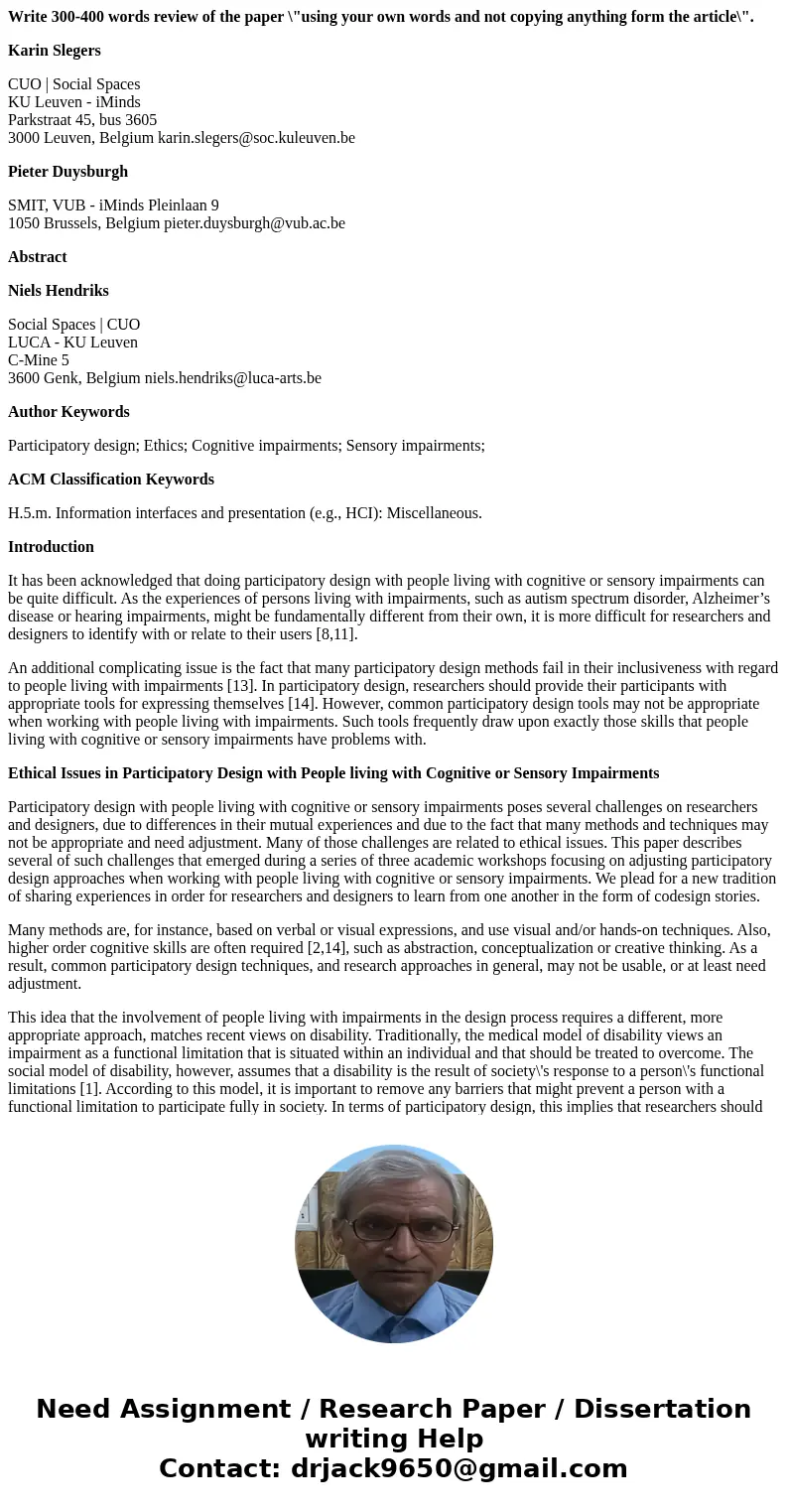
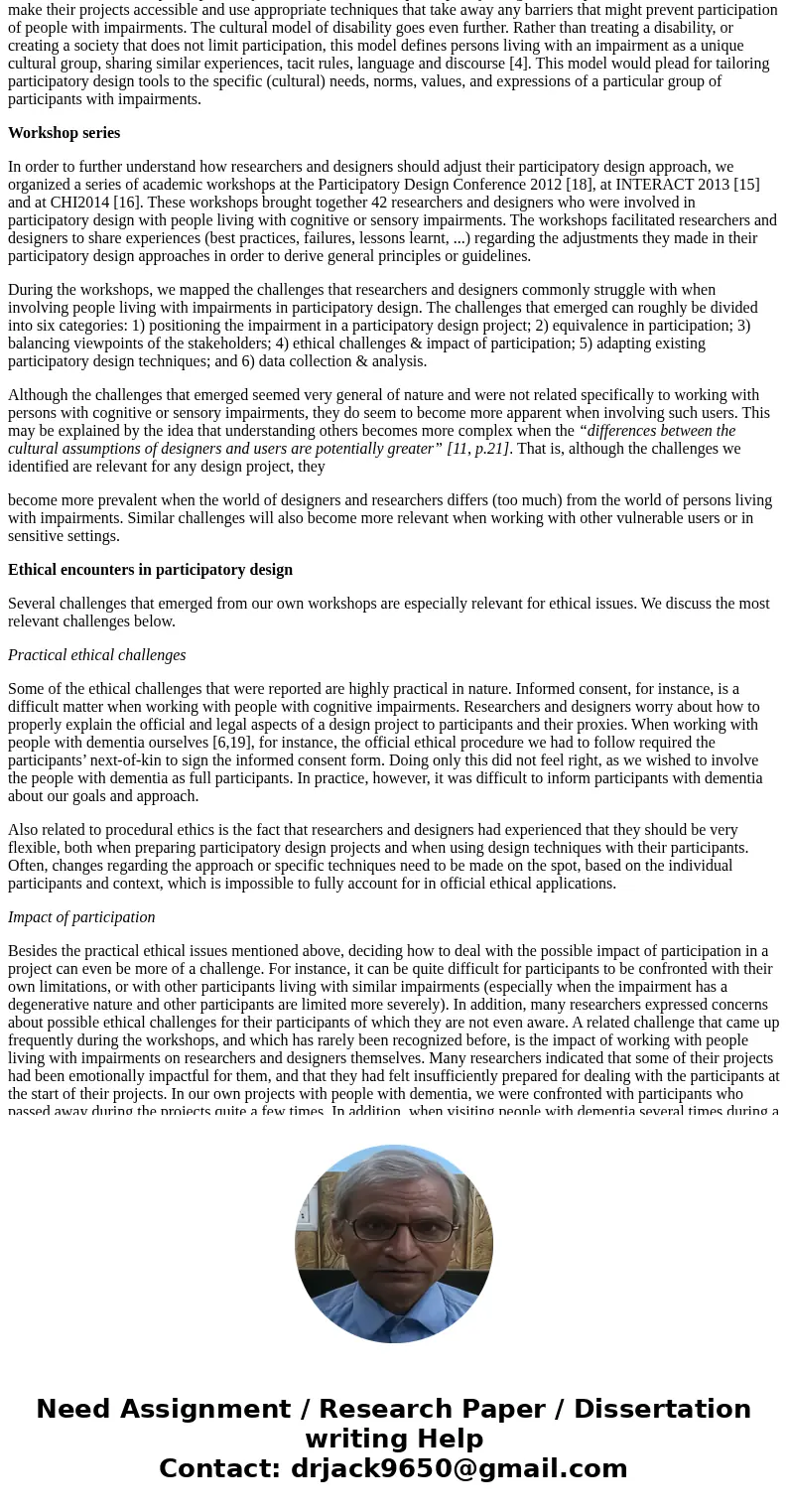
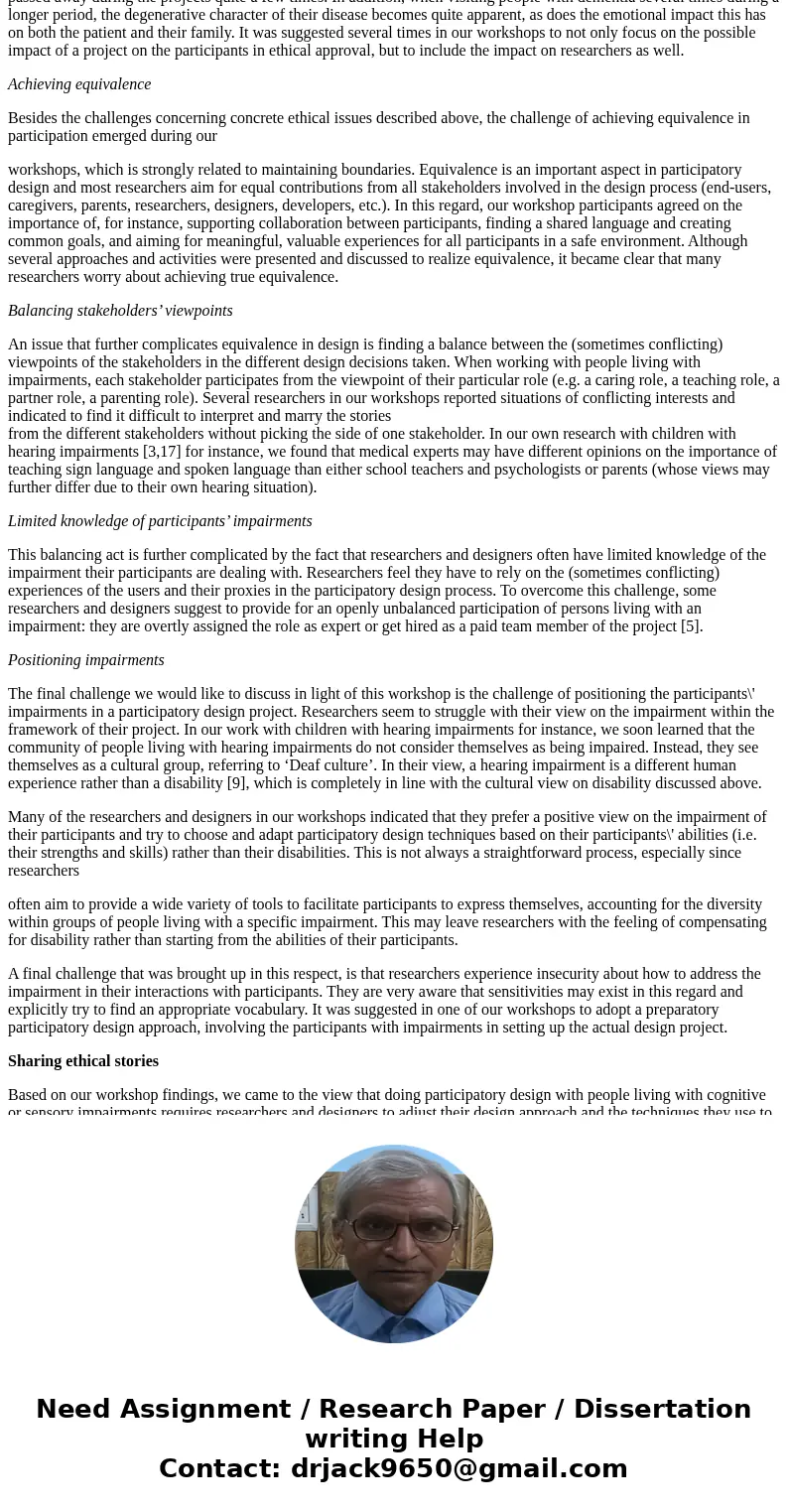
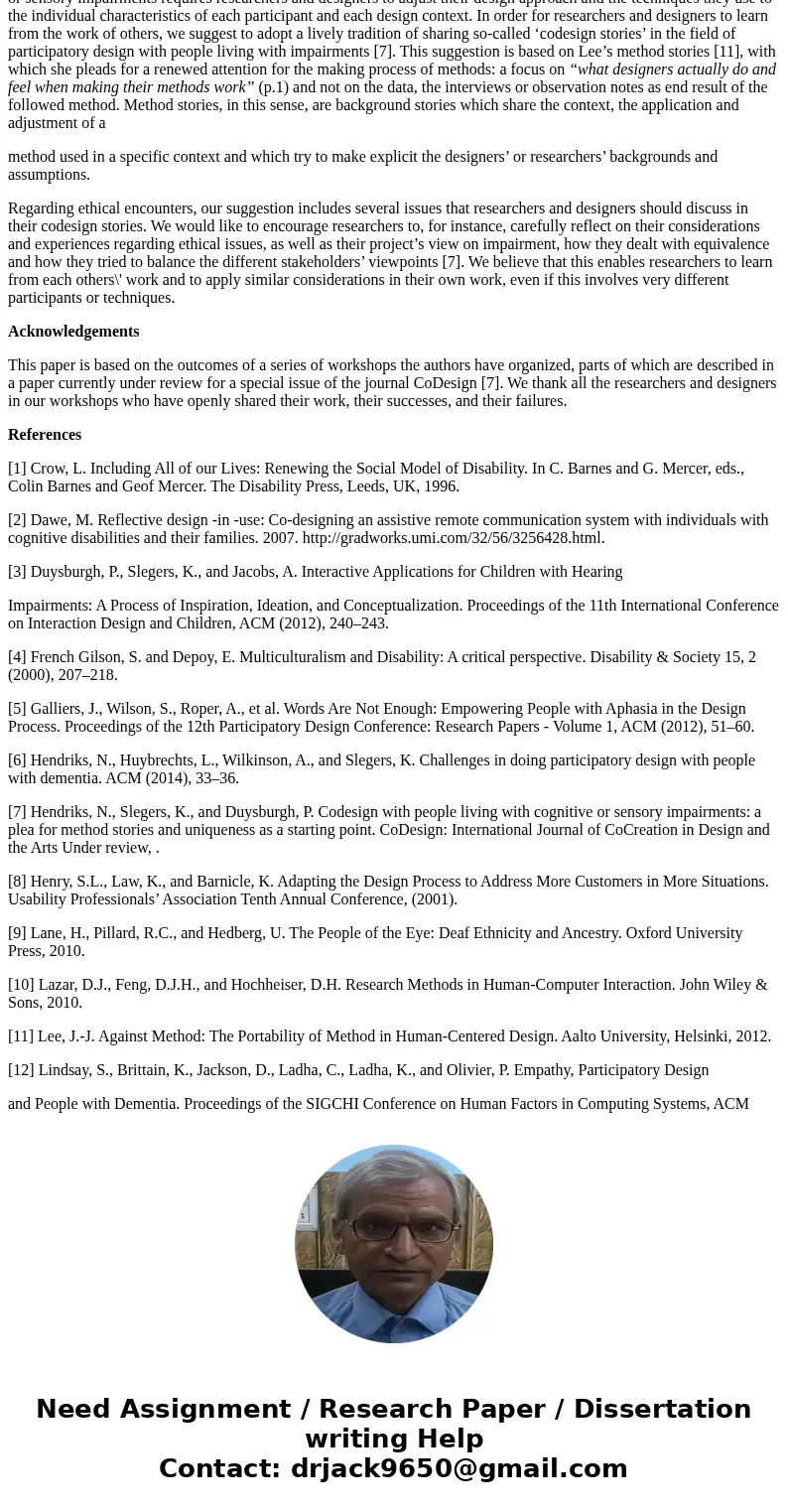
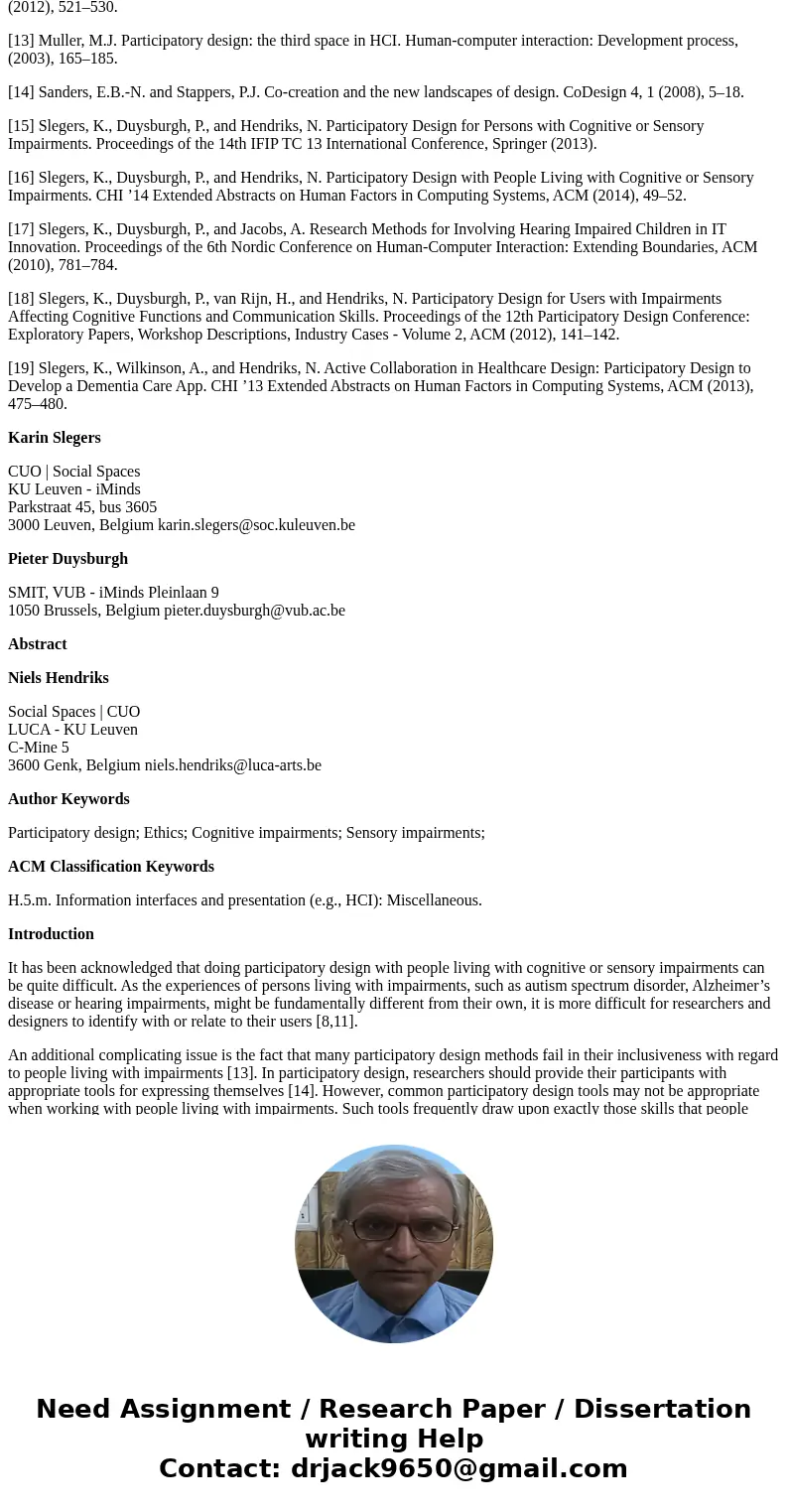
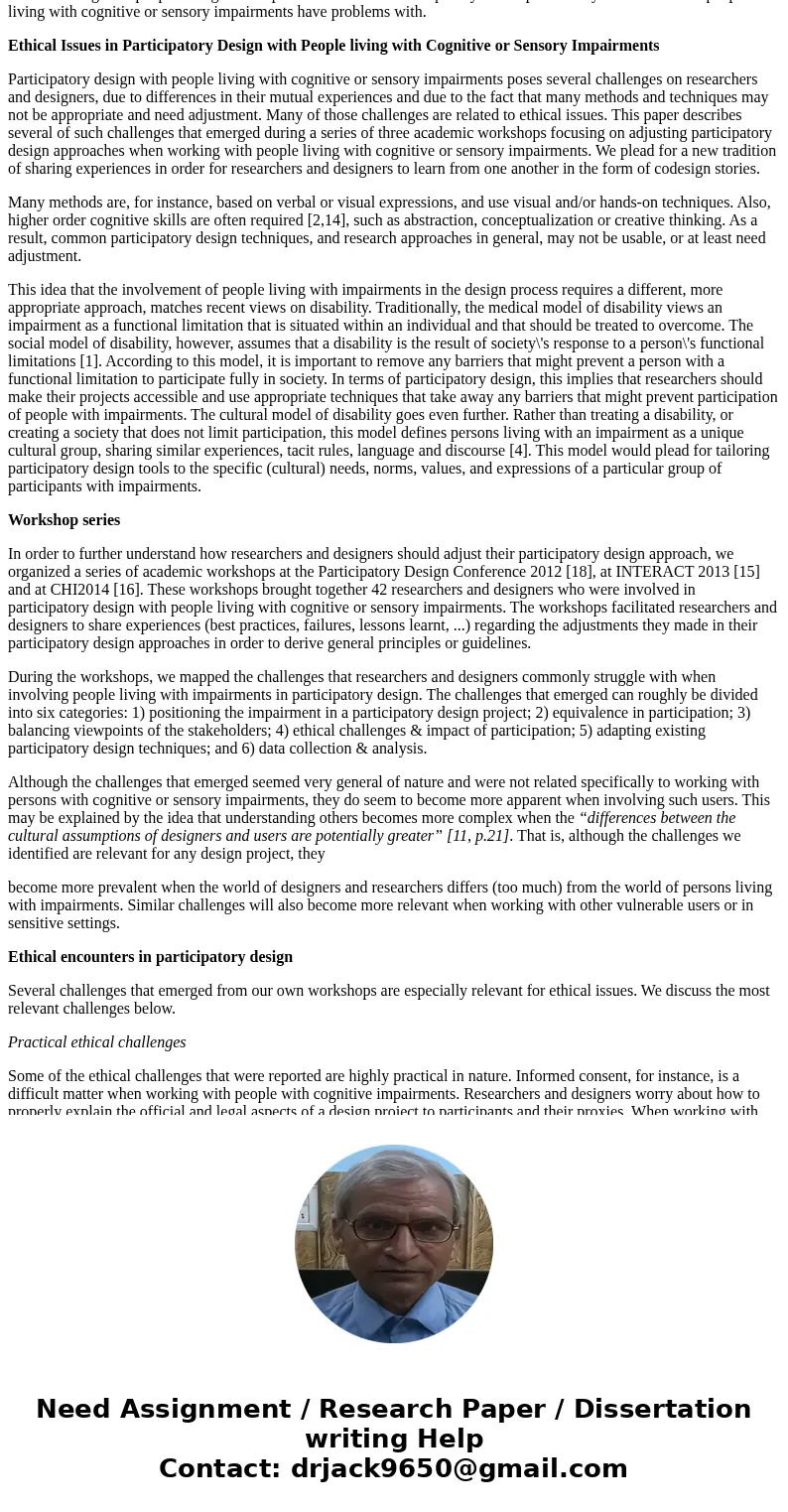
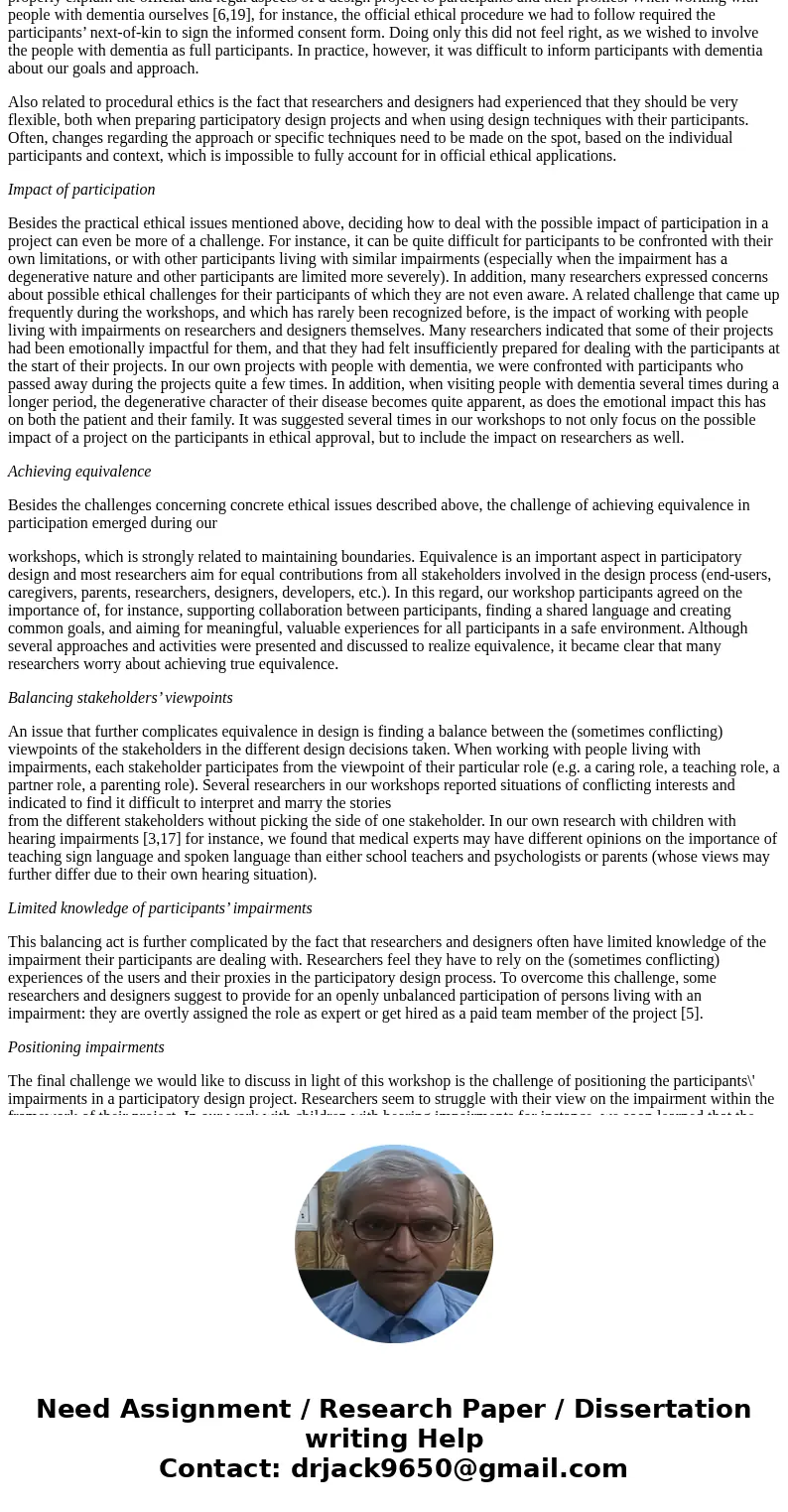
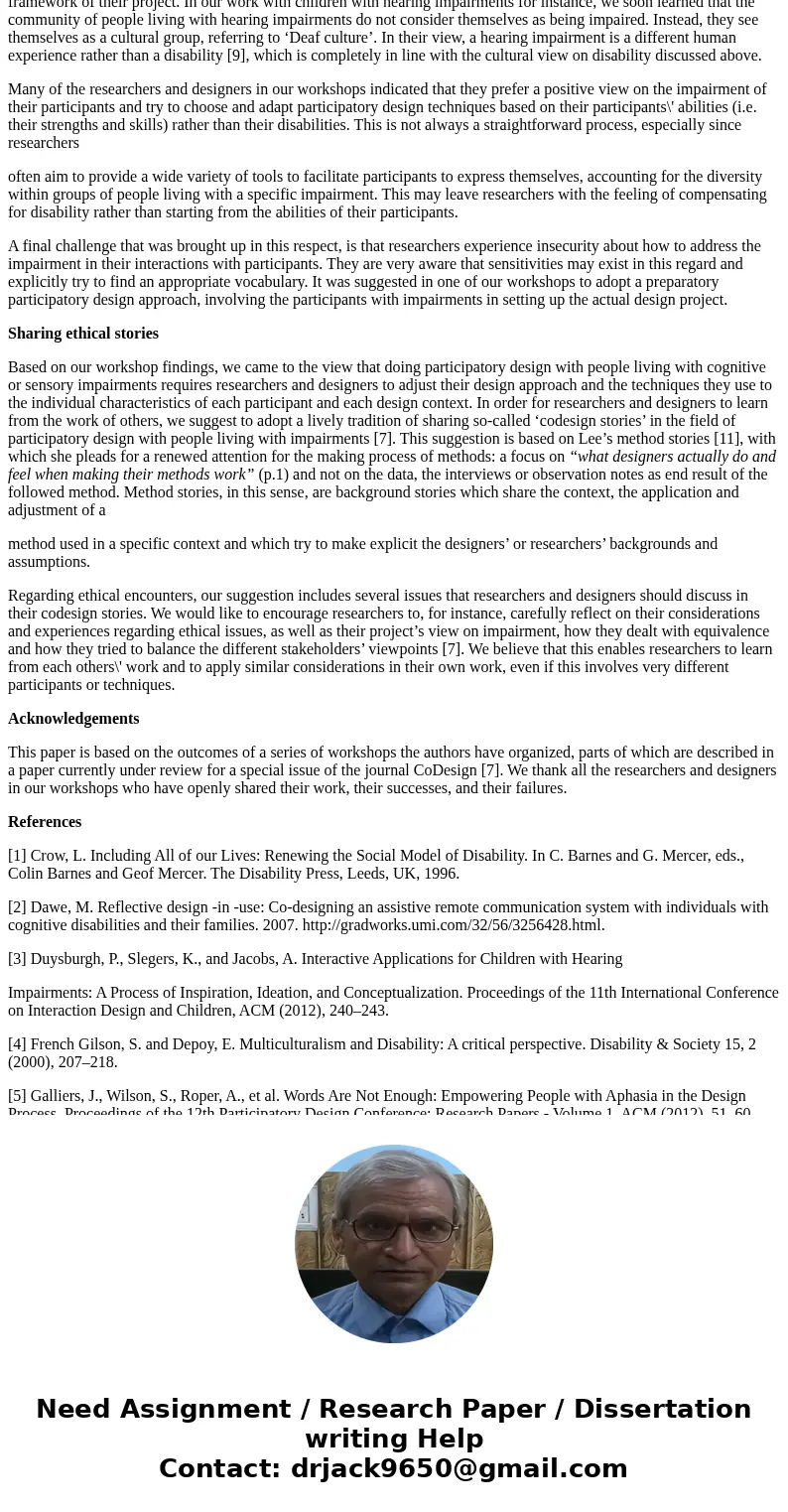
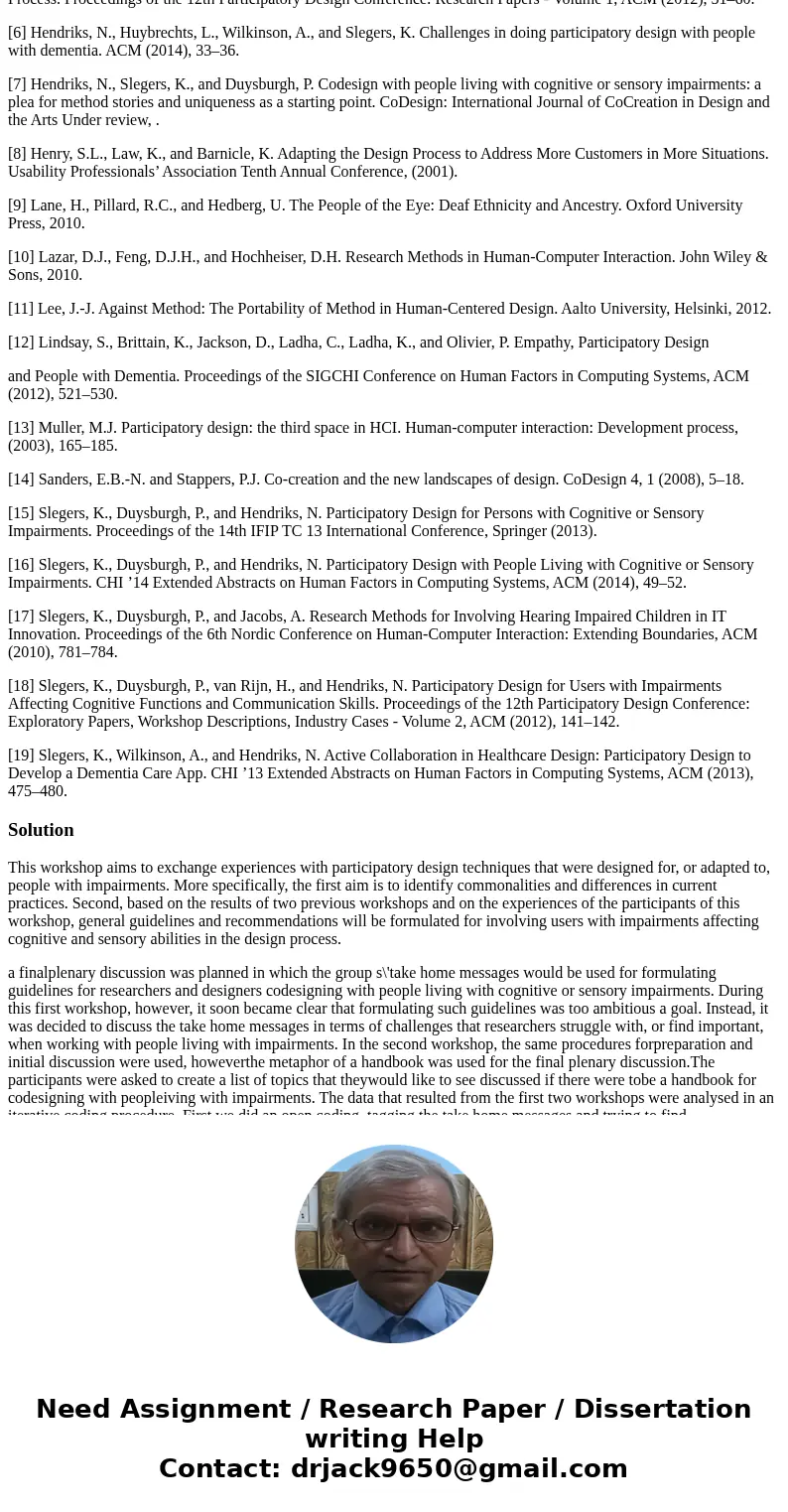
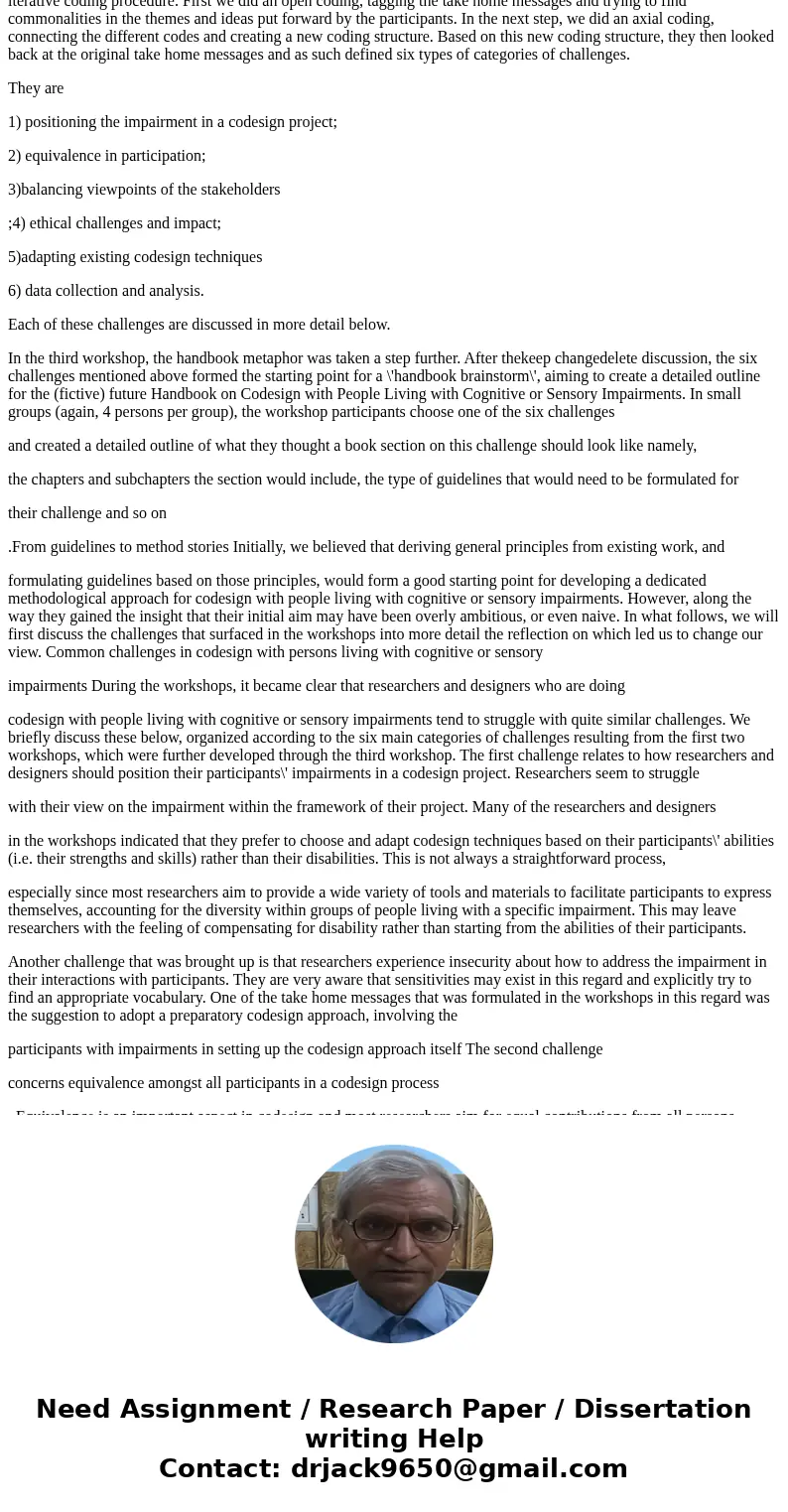
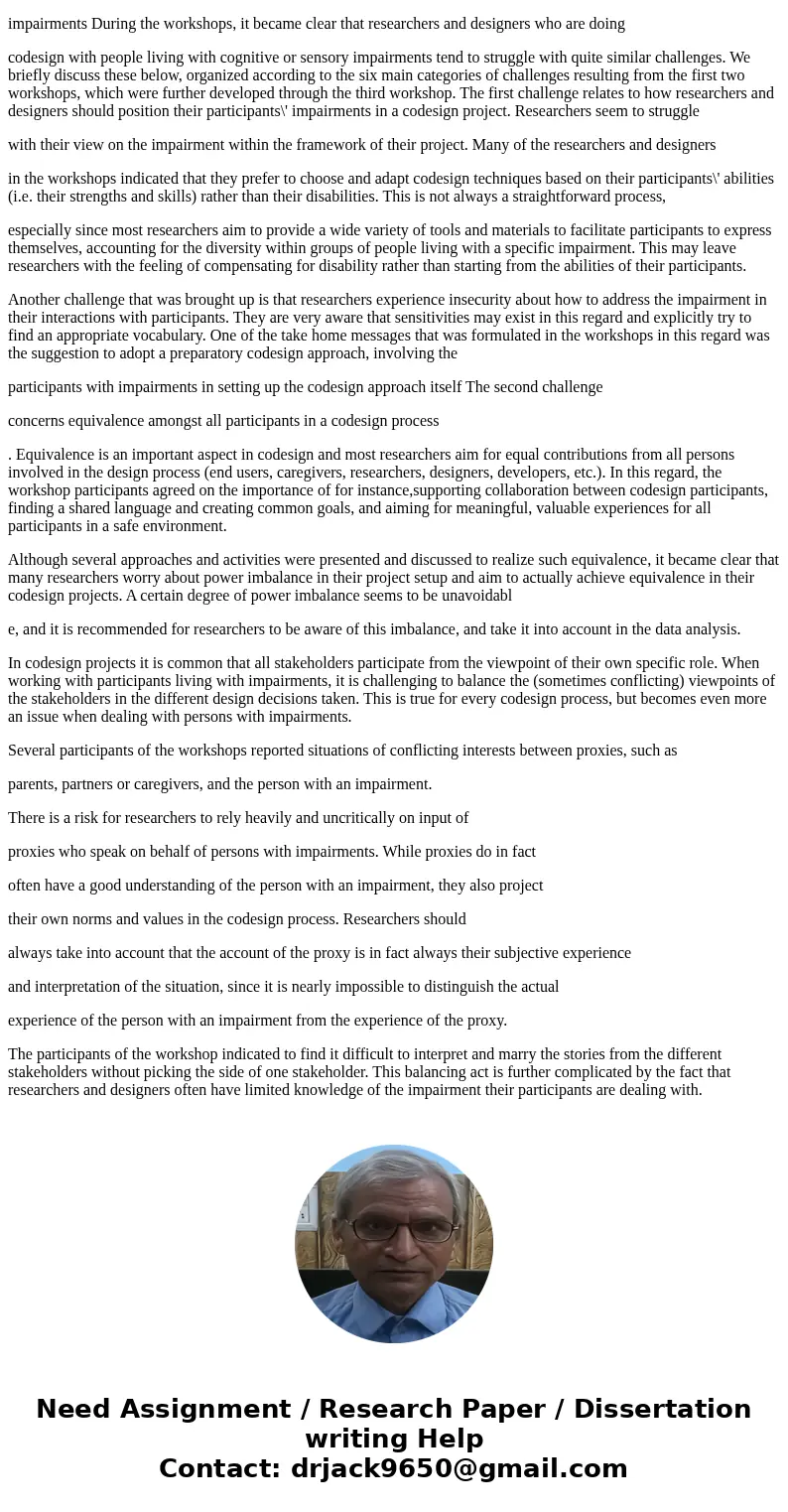
 Homework Sourse
Homework Sourse